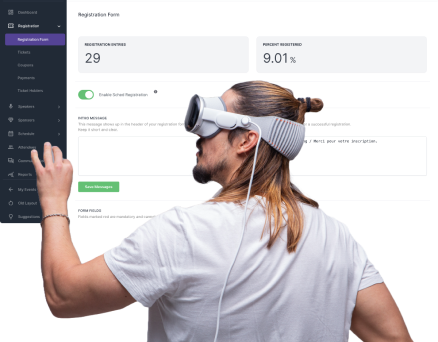Understanding how to measure sponsorship ROI is crucial for businesses seeking to justify their investments and ensure impactful marketing strategies.
Sponsorship ROI provides a tangible way to assess the benefits gained against the costs incurred, optimizing resource allocation and strategic planning.
By leveraging various metrics such as social media engagement, website traffic, and new customer acquisition, companies can gain insights into the effectiveness of their partnerships.
In this article, readers will explore practical approaches to calculating sponsorship ROI and learn how to maximize returns for their brand.
TL;DR
Table of contents
- 1 TL;DR
- 2 What Is Event Sponsorship ROI?
- 3 Why Is It Important To Measure The Sponsorship Investments?
- 4 How To Measure Sponsorship Effectiveness And ROI Accurately: 4-Step Guide
- 5 5 Best Practices To Increase Event Sponsorship ROI
- 6 11 Most Important Sponsorship Metrics To Track
- 7 Key Takeaways About Sponsorship ROI
- 8 FAQs
-
- Goal Setting: Clear objectives and goals are essential to gauge the success of sponsorship deals.
-
- Data Utilization: Leveraging data, including event app metrics and technology like RFID, helps track engagement and purchases. This approach aids in evaluating the effectiveness of the sponsorship.
-
- Adaptability: Staying adaptable allows brands to make informed adjustments to boost the impact of their sponsorship efforts.
-
- Relationship Building: Events provide opportunities to build and nurture relationships with customers, vendors, and prospects, enhancing brand visibility and credibility.
What Is Event Sponsorship ROI?
Event Sponsorship ROI refers to the return on investment a company receives from sponsoring an event. It evaluates the efficiency of the sponsorship by comparing the benefits gained to the resources invested.
The calculation typically involves measuring the net value generated against the net cost incurred.
Key Components:
- Net Value: Includes direct revenue, brand visibility, and enhanced reputation.
- Net Cost: Covers financial investment, time, and resources.
Formula:
Event ROI (%) = (Net Value / Net Cost) × 100
The target ROI may vary, with some brands looking for ratios like 2:1 or even 4:1.
The assessment often includes various metrics tailored to the sponsor’s goals.
Common Metrics:
- Brand Awareness: Increase in recognition and market presence.
- Lead Generation: Number of new contacts made during the event.
- Customer Engagement: Interaction levels with attendees.
Sponsors often develop custom ROI calculators to guide their decisions. Success depends on clear objectives and the leveraging of data to confirm the event’s contributions to those aims.
Adapting strategies based on ROI analysis is crucial for maintaining effective sponsorships.
Assessments not only define the current sponsorship’s value but also inform future investment decisions.
Why Is It Important To Measure The Sponsorship Investments?
Understanding the return on sponsorship investment is essential for businesses looking to optimize their marketing efforts. Measuring success helps determine whether sponsorships achieve their objectives.
Accurate measurement enables more informed decision-making.
Companies can identify which sponsorships align with their strategic goals and which may need adjusting.
This allows for better allocation of resources and ensures that marketing budgets are used efficiently.
Measuring sponsorship ROI also supports building strong relationships between brands and their partners.
By establishing clear goals and metrics, both parties can manage expectations and focus on achieving mutually beneficial outcomes.
A structured assessment of sponsorship investments helps organizations stay adaptable in a competitive market.
As market conditions change, businesses can adjust their strategies based on concrete data rather than assumptions.
Tracking specific metrics such as direct revenue generation, brand visibility, or audience engagement can provide insights that inform future marketing strategies.
This data-driven approach minimizes risk while planning subsequent sponsorships.
Finally, a comprehensive evaluation of sponsorship ROI can stimulate innovation within a brand’s marketing mix.
Companies may discover unexpected opportunities or insights that lead to new tactics and improved results.
How To Measure Sponsorship Effectiveness And ROI Accurately: 4-Step Guide
Step 1: Define Clear Objectives
Setting precise goals is crucial. Whether it’s brand awareness, lead generation, or sales, clear objectives allow for targeted measurement and analysis of results.
Step 2: Collect and Analyze Data
Gathering data is key to assessing sponsorship performance.
Combine metrics like unaided and aided awareness, engagement levels, and conversion rates for a holistic view.
Data-driven insights support effective decision-making.
Step 3: Implement ROI Evaluation Metrics
Consider integrating metrics like the ROI ratio.
For instance, if the sponsorship is valued at $30,000 and requested funding is $15,000, a 2:1 ROI is realistic.
This ratio helps in negotiating and determining success.
Step 4: Post-Event Assessment
After the sponsorship period, evaluate outcomes against initial objectives.
Look into long-term impacts, such as ongoing customer retention or improved brand perception, to gauge true effectiveness and ROI.
Monitoring both immediate and sustained effects enriches future strategies.
Using these steps, sponsors can gain valuable insights and drive meaningful results.
5 Best Practices To Increase Event Sponsorship ROI
1. Tailor Sponsorship Packages
Customizing sponsorship packages to align with the specific goals of sponsors is crucial.
Pre-event surveys can provide insights into sponsor priorities.
Tiered packages can cater to diverse goals and budgets, ensuring flexibility and relevance.
This targeted approach often leads to stronger partnerships and better outcomes.
2. Enhance Brand Visibility
Increased brand exposure is vital for sponsor satisfaction.
Offering multiple opportunities to showcase their brand—such as banners, branded experiences, and exclusive mentions—can boost visibility.
This not only benefits the sponsor but also adds value to the event by enriching attendee experience.
3. Leverage Virtual Presence
As events incorporate virtual elements, providing sponsors with digital ad space and virtual branding opportunities can be impactful.
This extends their reach before, during, and after the event, ensuring continued engagement and maximizing their return on investment.
4. Foster Strong Relationships
Maintaining open and honest communication is key.
Clear expectations, regular updates, and fulfilling promises create trust.
This builds long-term partnerships that encourage ongoing sponsorship, resulting in consistent support and mutual benefits.
5. Measure and Improve
Tracking and analyzing the effectiveness of sponsorship campaigns is essential.
Use quantifiable metrics to understand what works best.
Adjust strategies based on these insights for future events to continually enhance the sponsor experience and ROI.
11 Most Important Sponsorship Metrics To Track
Tracking sponsorship metrics is key for sponsors to evaluate success accurately.
1. Impressions
Measures the number of views the sponsorship receives, essential for understanding reach.
2. Engagement Rate
Tracks interactions such as likes, comments, and shares, offering insight into audience interest.
3. Sponsorship Recall
Indicates how well the audience remembers the brand post-event.
4. Brand Awareness
Evaluates the change in brand recognition through surveys or market research.
5. Demographics
Identifies audience characteristics to ensure alignment with target markets.
6. Brand Lift
Assesses the increase in positive perception and affinity toward the brand.
7. Lead Generation
Counts new leads acquired as a direct result of the sponsorship.
8. Sales Impact
Measures the conversion of leads into sales, providing a direct revenue link.
9. Customer Relationship
Examines the impact on customer loyalty and retention rates.
10. Value Perception
Surveys changes in how consumers perceive brand value post-sponsorship.
11. Competitor Analysis
Compares performance metrics against competitors engaged in similar sponsorship activities.
These metrics help sponsors fine-tune strategies, ensuring their investments drive meaningful results.
Key Takeaways About Sponsorship ROI
Choosing appropriate metrics ensures that both sponsors and brands can agree on what constitutes measurable success.
By staying adaptable and continuously analyzing data, brands can refine their strategies to maximize sponsorship ROI.
Events serve as a practical avenue for nurturing relationships with customers, vendors, and prospects, often resulting in significant benefits for the brand.
Understanding the value of sponsorship investments allows brands to make strategic decisions, enhancing both visibility and credibility in the market.
The right approach to measuring ROI not only benefits the brand financially but also strengthens its position in the industry landscape.
FAQs
What is a good ROI for sponsorships?
A good ROI for sponsorships often depends on the industry and specific goals.
Generally, sponsors aim for an ROI ratio of at least 2:1, meaning they expect to earn or save two dollars for every dollar spent.
Measuring ROI involves looking at both quantitative metrics, like sales increases, and qualitative metrics, such as brand awareness.
Setting measurable objectives from the onset ensures a clearer evaluation of the sponsorship’s success.
What makes a sponsorship program successful?
The success of a sponsorship program hinges on clear objectives, strategic partnerships, and ongoing evaluation.
Defining specific, measurable goals allows both parties to align their expectations.
Programs are more successful when sponsors and partners communicate effectively to leverage brand strengths.
Continuous monitoring and adapting strategies based on performance data can also help maximize overall impact and reach.
What do event sponsors get in return?
Event sponsors gain several benefits, including increased brand exposure, access to target demographics, and the opportunity to engage directly with potential customers.
Sponsorships can enhance brand image and credibility through association with popular events or causes.
Additionally, sponsors may get exclusive rights or privileges, such as speaking opportunities, booth space, and promotional signage, which further boost visibility and influence.
What are the most common mistakes when measuring sponsorship ROI?
Common mistakes include failing to set clear, measurable goals at the outset and relying too heavily on quantitative measures while ignoring qualitative outcomes.
Some sponsors may overlook tracking metrics consistently, leading to incomplete data and inaccurate conclusions.
Additionally, brands might misinterpret data or not adjust their strategies based on insights, which can hinder the assessment of true ROI.
What is value-in-kind sponsorship?
Value-in-kind (VIK) sponsorship involves providing goods or services instead of financial contributions.
This method is particularly useful for companies that can offer their products or services as part of the sponsorship.
It can help reduce costs for events, and in return, the sponsor receives similar recognition and promotional opportunities as cash sponsors.
VIK sponsorships are beneficial in industries where showcasing products in real-time offers added advantages.
What to look for in a sponsorship agreement for an event?
Key elements to examine include the scope of the sponsor’s benefits and obligations, and the event’s reach and target audience.
Also, look for exclusivity clauses that define competition. It’s crucial to understand performance metrics and how success will be measured.
The agreement should also clearly outline the duration, renewal terms, and exit strategies to safeguard both parties’ interests, and clarify mutual responsibilities.









